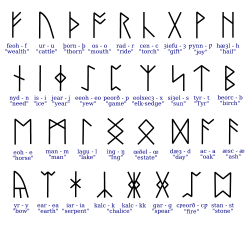Old English
Old English (Englisċ or Ænglisc) or Anglo-Saxon,[1] was spoken in Anglo-Saxon England from 450 AD to 1100 AD. It was spoken by the Anglo-Saxons, who came to Great Britain from what are now Germany and Denmark. Different Anglo-Saxon kingdoms spoke different dialects, but a western dialect became the main literary version. Both modern languages of England and Scotland (English and Scots) came from the language of the Anglo-Saxons.
| Old English | ||||
|---|---|---|---|---|
| Anglo-Saxon Ænglisċ, Englisċ, Anglisc | ||||
| Pronunciation | [ˈeŋɡliʃ] | |||
| Region | England (except the extreme south-west and north-west), southern and eastern Scotland, and the eastern fringes of modern Wales. | |||
| Ethnicity | Anglo Saxons | |||
| Era | mostly developed into Middle English and Early Scots by the 13th century | |||
| Language family | ||||
| Dialects | ||||
| Writing system | Runic, later Latin (Old English alphabet). | |||
| Language codes | ||||
| ISO 639-2 | ang | |||
| ISO 639-3 | ang | |||
| ISO 639-6 | ango | |||
| ||||
Old English is a West Germanic language and developed out of Ingvaeonic, which is very different from Modern English because it is closer to German than to English and has for its closest relatives Old Frisian and Old Saxon. It has many more Germanic words, difficult grammar and complex inflections.
In early centuries, Old English was rarely written down, and even then, it was in runes. After the 8th century, the Latin alphabet was used more often by churchmen like the Venerable Bede. After the Norman conquest of England in 1066, Old English was replaced by Anglo-Norman, which gradually turned into Middle English.
The epic poem Beowulf is written in Old English in an alphabetic script.
| Languages | wordlist | |||||||
|---|---|---|---|---|---|---|---|---|
| English | apple | path | eat | tide | make | child | give | day |
| Old English | æppel | pæþ | etan | tid | macian | cild | giefan | dæg |
| German | Apfel | Pfad | essen | Tide | machen | Kind | geben | Tag |
Old English Media
Alfred the Great statue in Winchester, Hampshire. The 9th-century English King proposed that primary education be taught in English, with those wishing to advance to holy orders to continue their studies in Latin.
Her sƿutelað seo gecƿydrædnes ðe ('Here the Word is revealed to thee'). Old English inscription over the arch of the south porticus in the 10th century St Mary's parish church, Breamore, Hampshire
The runic alphabet used to write Old English before the introduction of the Latin alphabet
A recording of how the Lord's Prayer probably sounded in Old English, pronounced slowly
References
- ↑ By the 16th century the term Anglo-Saxon came to refer to all things of the early English period, including language, culture, and people. While it remains the normal term for the latter two aspects, the language began to be called Old English towards the end of the 19th century, as a result of the increasingly strong anti-German nationalism in English society of the 1890s and early 1900s. However, many authors still also use the term Anglo-Saxon to refer to the language. Crystal, David (2003). The Cambridge Encyclopedia of the English Language. Cambridge University Press. ISBN 0-521-53033-4.
Other websites
- Old English -Citizendium
+{{{1}}}−{{{2}}}
| This language has its own Wikipedia project. See the Old English edition. |





